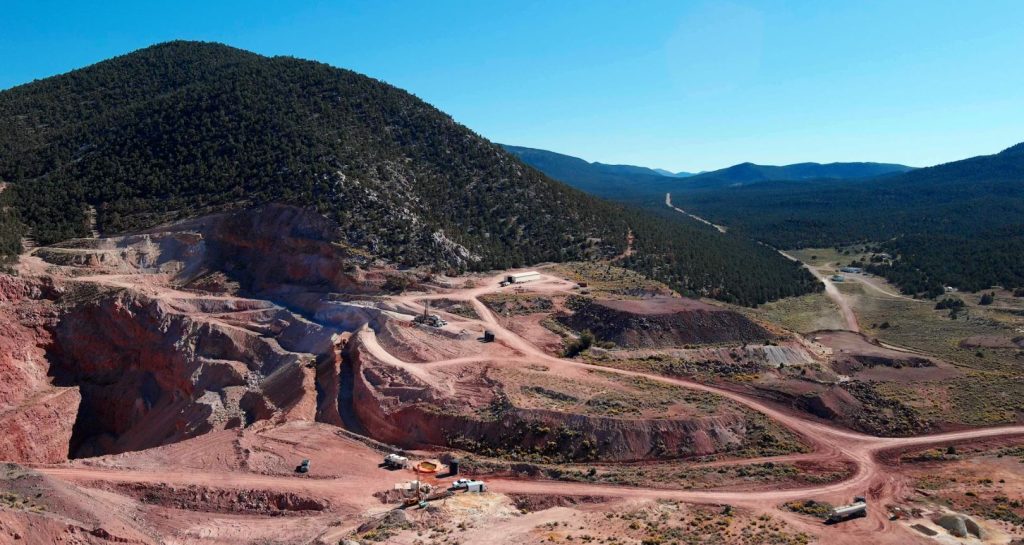Nevada King drills 1.43 g/t gold over 57.9M, 1.12 g/t over 45.7M and 1.15 g/t gold over 39.6M at Atlanta, Nevada

Nevada King Gold Corp. [TSXV-NKG; OTCQX-NKGFF) reported assay results from six reverse circulation (RC) holes recently completed at its Atlanta Gold Mine Project located 264km northeast of Las Vegas, Nevada, in the prolific Battle Mountain Trend.
Highlights: Drill hole AT23WS-38 returned 50.3 metres of 0.97 g/t gold and 5.2 g/t silver (WAGZ Zone); AT23NS-107 returned 39.6 metres of 1.15 g/t gold and 16.4 g/t silver (WAGZ Zone); AR23NS-166 returned 24.4 metres of 1.93 g/t gold and 51.3 g/t silver (AMFZ Zone); AT23-044 returned 22.9 metres of 2.39 g/t gold and 48.0 g/t silver (AMFZ Zone); AT23NS-128 returned 45.7 metres of 1.12 g/t gold and 58.8 g/t silver (AMFZ Zone) and AT23NS-122 returned 57.9 metres of 1.43 g/t gold and 24.0 g/t silver (AMFZ Zone). Holes released today were along Section 11N(2). Mineralization occurs along near-horizontal horizons with true mineralized thickness in vertical holes estimated to be 85% to 95% of reported drill intercept length.
Four of today’s holes crossed the Atlanta Mine Fault Zone (AMFZ) and were collared to fill-in drill pattern gaps and better define feeder faults. Good lateral continuity in mineralization is present, with gold and silver grades ranging from 1.12 g/t Au to 2.39 g/t Au and 24.0 g/t to 58.8 g/t Ag, while true thicknesses range from 22.9m to 57.9m. AT23NS-107 (39.6m @ 1.15 g/t Au) was a 17m step out to the south from previously released AT23NS-106 (41.2m @ 0.84 g/t Au) to test for lateral continuity of grade and thickness within the same fault block.
Sited in the western portion of the West Atlanta Graben Zone (WAGZ), hole AT23WS-38 (50.3m of 0.97 g/t Au) stepped out 40m westward from previously released AT23WS-26 (30.5m @ 0.33 g/t Au) and shows a three-fold increase in grade over a thicker interval, approaching the West Atlanta Fault #2. Historical core hole DHRI-11-NRC5 is located approximately 15m east of AT23WS-38 and intercepted 1.61 g/t Au over 61m and illustrates the variability in grade within the mineralized porphyritic dacite intrusive unit where grade is more structurally controlled compared to other portions of the resource zone.
Cal Herron, Exploration Manager, stated, “Today’s results along Section 23-11N(2) are located in the central portion of the Atlanta resource zone and continue to be very positiive. We know that the highest grades and thicknesses within the WAGZ occur in the southern portion of the resource zone along sections 4N through 9N and to the north along sections 14N through 17N, which is likely due to the presence of E-W trending faults cutting across these portions of the Atlanta system. Such E-W trending faults may also occur in the central portion of the WAGZ, where drilling density is lower and where several holes are pending that will ultimately be plotted on Sections 12N and 13N. As more hole results come in, we’ll get a much better handle on the grade distribution and in turn be more able to track higher grade structural corridors through this thick, low-grade blanket.”
Nevada King is the third largest mineral claim holder in the State of Nevada, behind Nevada Gold Mines (Barrick/Newmont) and Kinross Gold. Starting in 2016, the Company has staked large project areas hosting significant historical exploration work along the Battle Mountain trend located close to current or former producing gold mines. These project areas were initially targeted based on their potential for hosting multi-million-ounce gold deposits and were subsequently staked following a detailed geological evaluation. District-scale projects in Nevada King’s portfolio include (1) the 100% owned Atlanta Mine, located 100km southeast of Ely, (2) the Lewis and Horse Mountain-Mill Creek projects, both located between Nevada Gold Mines’ large Phoenix and Pipeline mines, and (3) the Iron Point project, located 35km east of Winnemucca, Nevada.
The Atlanta Mine is a historical gold-silver producer with a NI 43-101 compliant pit-constrained resource of 460,000 oz Au in the measured and indicated category (11.0M tonnes at 1.3 g/t) plus an inferred resource of 142,000 oz Au (5.3M tonnes at 0.83 g/t).
